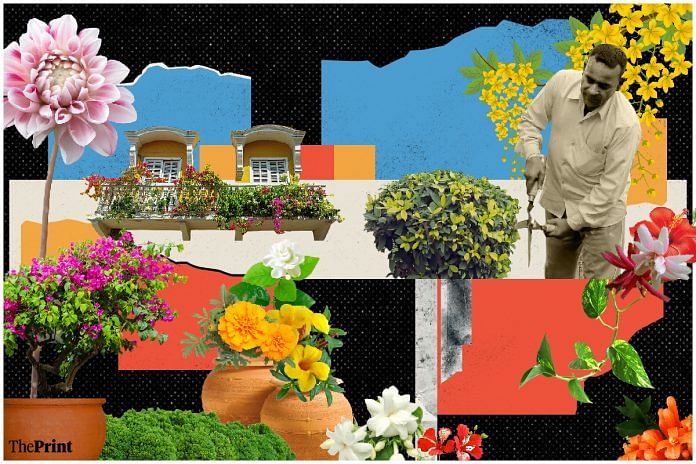It is often said that in business, three things dictate your success — location, location, and location. This was truer in the case of Delhi’s Masjid Nursery. Till around 1947, founder Munni Lal Saini’s family had lived near the sabzi mandi and done farming on a leased piece of land near Gulabi Bagh. But it was hardly profitable.
In 1948, taking a huge leap of faith, Saini took a large piece of land next to the Masjid Nursery in Pandara Road on lease. The land was oddly shaped, uneven, and undulating. But gradually, the area got developed — the popular Khan Market came up on one side and the elite Sujan Singh flats on the other side of Masjid Nursery. Placed close to Lutyens’ Delhi where the British officers lived, Masjid Nursery’s business of selling flowers and potted plants to the expat community, diplomats, and British officers began to pick up.
A British fascination
The British had always been besotted with foliage and flowers, and Saini fed their passion by supplying cut floral arrangements of roses, hibiscuses, gladioli, and lilies. The expats used to decorate their wide verandas and colonial bungalows with all kinds of hanging plants and creepers. So Saini would send them wooden crates filled with Rangoon creepers, money plants, bougainvillea, flame vine, Allamanda vine, and a host of local fragrant hedges and bush plants like jasmine and chameli. People also liked to fill their gardens with ornamental trees such as frangipani, drooping bottle brushes, gulmohar, amaltas, and all kinds of palms. Copious amounts of these saplings were grown in Masjid Nursery and then transplanted to the colonial houses and private bungalows.
British town planners were fascinated by India’s towering endemic tree species such as peepul, neem, arjun, kachnaar, kadamb, and specially pilkhan (Indian fig), which provided soothing shade from the harsh summer sun and a refuge to local birds and insects. The British planted them in abundance around the peripheries of their houses and on all the residential roads and pavements. In essence, the expat community’s passion for greenery provided lucrative business opportunities for Munni Lal. He promptly took on more land on lease and also set up Kamal Nursery on an adjoining piece of land.
“Our nursery got a big boost in 1965 with the entry of USAID (United States Agency for International Development). A large number of American expats settled down near Pandara Road. The demand for exotic plants increased, and we started getting trees and plants from hubs in Calcutta in lorries and train wagons,” says Vikram Saini, the current owner of Masjid Nursery.
Also read: Bina Musicals’ harmoniums haven’t lost the tune. It started with British order and a blessing
Changing trends
Over the years, the trend of landscaped gardens became popular among upscale Indians as well. Exotic seeds, designer pots, and even new gardening tools became objects of fascination. As demand for new colours, shapes, and plant species increased, the Saini family decided to tap into nurseries in Bangalore (Bengaluru), Pune (Maharashtra), and Kadiam in Andhra Pradesh.
People are acutely aware of changing trends in wearable fashion — but fads come and go in horticulture too. Much through the ’50s and ’60s, gardens were groomed and manicured — levelled grounds with perfectly shaped flower beds and a preference for classics such as rose, marigold, hibiscus and dahlia. In large gardens, there would be a fountain or two spouting neat squirts from the top.
But all that changed over time. Gardens became more ‘zen’ with undulating surfaces, grey and black cobblestoned pathways, seasonal flowers, and water flowing quietly over the surface.
Another shift has happened in the last few years. People now want something akin to a tiny city forest with wild grass, exuberant seasonal flowers, meandering paths, large rough rocks and curios in their home and office landscapes.
“Earlier, there were terracotta pots. Then came cement pots and plastic pots. Now people prefer porcelain, and, in fact, the new trend is gunny bags because they look dramatic and allow soil and plant roots to breathe. Earlier we used thick clay soil, now we use coco peat inside pots and flower beds. The romance of the vertical wall is over now. Everyone realises that it uses too many plastic pots and [results in] endless wastage of water. People are shifting to more sustainable plantations by creating green walls with authentic endemic Indian trees like Sal, which have large leaves and beautiful foliage,” explains Vikram.
Life is always in motion like a pendulum. The more concrete we pour into our cities and environment, the more intense our desire to infuse flowers, creepers, hedges, and trees in our landscapes. In fact, greenery has become one of the most sought-after features in new buildings — both in office and residential spaces. And this has catapulted the ‘green’ business of units like Masjid Nursery into a lucrative spin.
This article is a part of a series called BusinessHistories exploring iconic businesses in India that have endured tough times and changing markets. Read all articles here.



